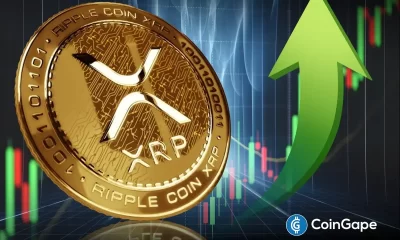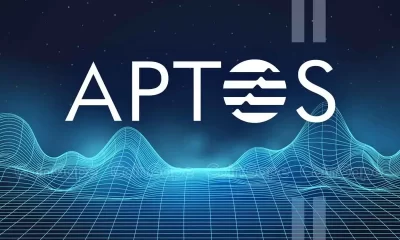Technology
Filmmakers Bet on Web3 to Fix Hollywood Film Financing
Published
3 months agoon
By
admin

Cutter Hodierne knew the odds were against him. As an independent filmmaker trying to secure funding for “Cold Wallet,” a crypto thriller about a heist gone wrong, he faced the usual hurdles—hesitant investors, an unpredictable industry, and a financing system that favored big studios over fresh voices.
“In Hollywood’s centralized model, breaking in is difficult,” he said. “You never know if you met the right person, if your script was overlooked, or if your work is truly considered.”
So instead of taking the traditional route, he turned to the decentralized film industry. Often referred to as Film3, it leverages blockchain technology, community voting, and cryptocurrency to fund movies, and television series. Unlike the traditional Hollywood system, which relies on centralized studios, agents, and intermediaries, Film3 lets filmmakers connect directly with their audiences and financing.
Hodierne put 10 minutes of his film up on the Decentralized Pictures website for review, where a community of producers, writers, investors, and film buffs got a look at his sizzle reel. In exchange for reviewing the clip, they earned $FILM, Decentralized Pictures’ token, which the studio says is “fuel for the platform. Users can stake them on their favorite projects, use them to pay others to review their own submissions (as a rewards pool), or simply purchase entry vouchers to pay for application fees for various creative financing rewards.”
One reviewer in particular was especially struck by the clip: “Steven Soderbergh, the king of the heist genre, gave us his blessing,” said Hodierne.
Soderbergh invested in the film, and Decentralized Pictures followed on with a grant, giving “Cold Wallet” enough money to make Hodierne’s movie. Now screening as a “Steven Soderbergh Presents” project, the movie is at select theaters and available for rent or purchase on Apple and Amazon Prime Video, and has garnered respectable reviews.
“Hopefully, it connects with viewers,” Hodierne said. “What excites me most is that you can rent and buy it on-chain with crypto—it’s highly appropriate.”
It’s another big step in the journey of the dominant studios in the Film3 movement, Decentralized Pictures and Gala Films, which have more than 60 movies and TV series in the works.
“We’re building the studio of the future,” said Decentralized Pictures co-founder Roman Coppola, a member of the Coppola filmmaking family. “At our company, American Zoetrope, and in my dad’s work, we value community and a cafe culture where people come together, share ideas, and compare notes.”
Coppola and others pointed out that just as important as community participation is the decentralized funding model that can support filmmakers, particularly those with distinctive voices and meaningful stories to tell, by allowing them to bypass industry hierarchies.
“The term we’ve been using—DeFiFi, decentralized film finance—represents a shift in film funding,” Stacy Spikes, co-founder of movie subscription platform MoviePass said during an interview with Decrypt at ETH Denver. “Distribution companies will still be needed to push films into the marketplace, but until now, back-end participation wasn’t possible. With smart contracts, it is.”
The idea is already gaining traction. In 2024, Film3 made history when actress Mena Suvari earned a Primetime Emmy nomination for her role in “RZR,” a sci-fi series created by David Bianchi’s Exertion3 Films in collaboration with the blockchain-powered streaming platform Gala Film.
Spikes likened the potential of decentralized filmmaking to past independent and genre film movements.
“If you go with the community—particularly black and brown communities or genre films—Web3 is a great place to tap into,” Spikes said. “I feel that people who were hesitant to invest will now be more likely to do so because they know they’ll get their money back.”
Hodierne also noted that by eliminating distributors and sales agents, all proceeds go directly to the filmmakers and Decentralized Pictures, allowing them to reinvest in independent artists and future projects.
“As a filmmaker, I’ve seen how centralized and fickle the industry is. This shift is a big deal, especially as streaming platforms pay artists less while struggling themselves,” he said. “It’s an exciting convergence for films, and for ‘Cold Wallet,’ a crypto thriller, this feels like the perfect first step in opening that door.”
Daily Debrief Newsletter
Start every day with the top news stories right now, plus original features, a podcast, videos and more.
Source link
You may like


Dow gains 214 points, markets end higher as strong labor data eases tariff concerns


Ethereum Price Headed For Crash To $2,000 With Current Price Action


Tokenized funds hit $5.7B, scaling fast — Moody’s


Authorities Warn of Phony Text Messages Phishing for Sensitive Information, Telling Victims Their Bank Account Is at Risk


Tether invests in Chilean crypto exchange Orionx


MARA Hits Record-High Bitcoin Production in May
Technology
Ethereum Foundation Restructures R&D Division, Plans ‘Rethink’ on Design and Development
Published
14 hours agoon
June 3, 2025By
admin

In brief
- The Ethereum Foundation is restructuring its Protocol R&D teams under the “Protocol” brand, a new initiative umbrella.
- Three strategic initiatives are expected to target scaling Layer 1, scaling blobs, and enhancing the user experience.
- Some team members won’t continue with the foundation as the organization streamlines operations.
Less than a month after the Pectra Upgrade, the Ethereum Foundation believes that the world’s second-largest crypto, both as a technology and as an ecosystem, is approaching major breakthroughs with higher stakes for a broader audience.
Yet those stakes could be at risk if the people steering it are entrenched in what it calls a messy process: shipping protocol.
“We must rethink our current approach to designing, developing, and stewarding the protocol,” the foundation wrote Monday, announcing the restructuring of its Protocol Research & Development teams.
The move is set to consolidate development efforts under a new “Protocol” division, focusing on three immediate goals. The foundation touts the move as a way to “respond proactively” to demands that it claims are “hard to articulate and even harder to fulfill.”
“Ethereum already powers the lion’s share of internet capital markets, onchain communities, and secures $200 billion plus in value,” Binji Pande, growth lead at Ethereum Layer 2 scaling solution Optimism, told Decrypt. “Protocol now gives it the clarity and execution it deserves by scaling what works, improving UX, and keeping Ethereum useful for the world.”
The overhaul divides teams into three initiatives: scaling the main blockchain (Layer 1), scaling blobs for data storage, and improving the user experience.
Each initiative is assigned dedicated leadership: Tim Beiko and Ansgar Dietrichs are responsible for L1 scaling, Alex Stokes and Francesco D’Amato will oversee blob scaling, while Barnabé Monnot and Josh Rudolf are tasked with improving user experience.
But not everyone is staying and making the cut for Protocol. Some members “won’t be continuing with the Ethereum Foundation,” it said, while encouraging ecosystem projects to recruit departing talent.
Decrypt reached out to the Ethereum Foundation to learn more.
Strategic roles
The three teams will be supported by Dankrad Feist, a prominent researcher and cryptographer renowned for “Danksharding,” a blockchain optimization process named after him. Feist will work as strategic advisor to all tracks.
Last year, Feist was involved in a conflict of interest controversy, when he, alongside fellow core developer Justin Drake, confirmed they received tokens for their advisory relationship with EigenLayer, a restaking protocol for Ethereum.
“It is clear that relying on culture and individual judgment has not been sufficient, and we have been working on a formal policy to address this,” Aya Miyaguchi, the foundation’s former Executive Director, said at the time.
Still, the Ethereum Foundation’s efforts at restructuring with Protocol aim to bridge a perceived gap between research and actual implementation.
Previous upgrades, such as Pectra, faced several hurdles: testnet failures earlier this year delayed the rollout by weeks as developers scrambled to patch bugs.
Now, through Protocol, the foundation is attempting to show “the world is ready for the world computer.”
Edited by Sebastian Sinclair
Daily Debrief Newsletter
Start every day with the top news stories right now, plus original features, a podcast, videos and more.
Source link
Technology
Is Free Will an Illusion? Quantum Experiments Aim to Find Out
Published
6 days agoon
May 29, 2025By
admin

In brief
- Researchers are designing quantum experiments to test whether human choices are truly independent of outside forces.
- The new work challenges the assumption of measurement independence in quantum entanglement.
- UC San Diego Professor of Philosophy Eddy Chen says defining free will remains a deeply contested issue.
New quantum physics experiments may soon test a question as old as humankind: Do we truly have free will?
Researchers say they are closing in on a way to determine whether our choices are truly our own or dictated by hidden laws of physics, according to a report published in New Scientist on Tuesday.
Quantum experiments have been designed to test the so-called “measurement independence assumption,” which proposes that hidden variables do not influence the settings chosen by experimenters, thereby proving or disproving the existence of free will.
“Many religions resolve the conflict between the concept of an omniscient God and God’s commandment not to commit sin by assuming human beings have partial free will,” University of Seville Professor Adan Cabello wrote in the report. “But if partial free will is not possible, neither is this resolution.”
In the report, the researchers developed new tests based on Bell’s inequality, also known as Bell’s theorem, a principle introduced by physicist John Bell in 1964 to demonstrate whether entangled particles exhibit correlations that can’t be explained by classical physics.
This assumption tests quantum entanglement, where particles appear to coordinate their behavior instantaneously across large distances.
Defining free will
In quantum computers, entanglement links qubits so that the state of one instantly affects the state of another, regardless of their physical separation, allowing the system to perform complex calculations in multiple directions simultaneously.
By loosening that assumption and considering the possibility that choices aren’t entirely free, the team hoped to determine whether the connections between entangled particles—known as non-local correlations, which are instantaneous across vast distances—are a fundamental feature of quantum mechanics or the result of some hidden force at play.
The concept of free will has deep roots in Western thought, emerging in ancient Greece with philosophers such as Aristotle, and shaped by Christian theology’s emphasis on moral responsibility. It later evolved through Enlightenment ideals of individual autonomy.
According to the University of California at San Diego professor of philosophy Eddy Chen, any attempt to link quantum mechanics to free will depends heavily on how free will is defined—something even philosophers and physicists often disagree on.
“Even those who’ve studied this for years struggle to define it, and seemingly clear definitions remain controversial,” Chen told Decrypt. “If you accept one, others may not. So whether quantum mechanics can prove or disprove free will depends on how free will is defined.”
A fellow of the John Bell Institute for the Foundations of Physics, Chen said that while science can inform philosophical questions, it often remains neutral on matters involving values, ultimate causes, or the nature of reality itself.
He explained that issues like free will or randomness may have scientific implications if certain assumptions are made, but those assumptions themselves are open to challenge and scrutiny.
“Some debates, especially about philosophical concepts like free will, rely on reasoning rather than empirical testing,” he said. “Science can settle questions with clear definitions, but murkier concepts are harder to resolve experimentally.”
Hidden links
The researchers’ new approach expands on Bell’s theorem by exploring scenarios where experimenters might have only partial free will, meaning their choices are not entirely independent, but still contain some degree of autonomy. According to Chen, this doesn’t weaken the argument, but broadens its implications.
“They’re not saying we lack free will. Even if someone has only partial free will, the theorem still applies,” Chen said. “As long as there’s some freedom, local interactions alone can’t produce quantum predictions. So Bell’s theorem applies not just to full freedom, but also to universes with partial freedom.”
When asked what might be controlling the “other half” of human choice if free will is only partial, Chen said finding this answer would require a radically new theory—one that not only explains everyday physics but also accounts for the hidden links between distant decisions.
“A skeptic might argue for a new physical theory that explains not only what we see, but also the hidden connections between your choice and mine, even though we’re far apart,” he said.
“Until such a theory exists, we take this seriously. This theorem may apply in cases where no such local theory can work. It’s not just hard to construct—it’s mathematically impossible.”
Quantum experiments may not resolve the debate over free will, but they are beginning to change our understanding of it.
Even a little bit of choice, researchers say, is enough to rule out simple explanations, suggesting the real mystery isn’t whether free will exists, but how much of it we actually have.
Edited by Sebastian Sinclair and Josh Quittner
Generally Intelligent Newsletter
A weekly AI journey narrated by Gen, a generative AI model.
Source link

Disclosure: The views and opinions expressed here belong solely to the author and do not represent the views and opinions of crypto.news’ editorial.
Right now, protocols are stuck: cycling between incentive-driven inflows and inevitable outflows of liquidity as providers chase higher and higher returns. Even with existing bridging and wrapping solutions, because of concerns around complexity and security, most retail investors are unable to or unwilling to distribute their assets effectively across protocols.
This leaves over $400 billion worth of idle assets locked across siloed chains whilst protocols across DeFi compete for limited liquidity, their demand vastly outsizing the available supply. Without a global liquidity to unlock these idle assets and enable a shared source of liquidity, DeFi will struggle to supplant traditional finance and reach global adoption.
The liquidity problem
Traditional finance thrives on deep, integrated capital markets. The centralized structure of global banks means that liquidity thresholds can be proactively regulated to maintain solvency, and the sheer number of participants in permeable global markets means that there is always capital circulating within any given system.
DeFi, by contrast, remains fragmented. A lack of compatibility between competing chains fractures the liquidity of an already small user base, whilst nontechnical participants may struggle to move their assets with the interoperability solutions that currently exist. This limits the capabilities of DeFi as a financial system; simply put, people are able to do less with their capital. This problem is captured in the one-two punch of stagnation and underutilisation.
Without access to sufficient liquidity, emerging products struggle to maintain trading volumes, lending capacity, and user activity. To attract liquidity, new projects issue native tokens and offer high APYs or governance rewards. However, whilst these strategies succeed in the short term, this capital remains trapped within individual ecosystems.
These ecosystems suffer from sharp outflows when rewards taper off or are bettered elsewhere, slowing down the growth of new and potentially innovative projects. We even see this manifest in formerly dominant protocols, with Ethereum (ETH) struggling in the last year. This has come from a cultural shift in DeFi away from promises of long-term utility and instead towards quick returns on memecoins based on Solana (SOL), drawing capital from one silo to another in the process.
Both the symptoms and causes of some of these liquidity issues are the vast amount of underutilised capital across DeFi. Unlocking this capital also provides a key solution. When we talk about $400 billion worth of idle assets in DeFi, we are talking about ‘premier’ tokens like XRP (XRP), Bitcoin (BTC), Dogecoin (DOGE); tokens with a high market cap, but a comparatively low TVL.
These tokens either lack the opportunity to be utilized effectively in staking and trading, or many of their holders lack the technical ability or interest to stake and restake for optimised yield. This represents a substantial imbalance in overall asset valuation and the associated DeFi protocol activity. If we could rectify this imbalance, there would be a flood of liquidity into the market. This would jumpstart the process of investment and innovation that DeFi needs.
Towards a global liquidity layer
If DeFi is to break free from the cycle of fragmented liquidity and short-term incentives, it must follow TradFi’s lead. Most importantly, it needs to develop a shared liquidity infrastructure to enable the frictionless flow of assets that prospective users have come to expect.
The industry is not blind to these problems, and early steps toward global liquidity are already underway. Protocols like Wormhole and LayerZero allow smart contracts to complete orders across chains. Elsewhere, intent-based protocols and advancements in zero-knowledge proofs are beginning to push the boundaries of DeFi’s UX, making capital movement as simple as in TradFi offerings.
A unified liquidity layer could create, for instance, an XRP market on Solana, a DOGE market on Avalanche (AVAX), and a Cardano (ADA) market on Base. This would enable DeFi projects to function like large-scale TradFi institutions, benefiting from deep and stable capital pools, reducing the need for constant incentive programs.
Over time, this would eliminate the short-termism of APY wars, encouraging lenders to deploy assets with greater confidence, with a unified liquidity framework mitigating exposure risks without compromising returns. Capital would be fully utilised, liquidity would flow freely to where it is needed, and DeFi’s growth would accelerate.
For retail users, this would be a breakthrough. With accessible cross-chain markets, retail investors could easily diversify their assets without having to navigate complex bridges or take unnecessary risks. Furthermore, simplified UX would lower technical barriers, making staking, lending, and trading accessible to users from day one. With reduced exposure, retail users could confidently engage in DeFi, driving adoption, introducing billions of dollars to new markets, and allowing DeFi to reach its lucrative potential.
However, if DeFi is truly serious about global liquidity, major ecosystems must move beyond isolated solutions and establish shared standards through interoperable liquidity hubs or decentralized coordination mechanisms. Founders and developers must collaborate for a healthy and prosperous ecosystem, not compete for limited resources.
The shift towards unlocking the free-flowing markets of DeFi’s future needs more than one single market-busting product. It will come from a sustained industry-wide effort: a cultural shift towards ambitious and user-friendly product offerings that take into account the needs of both the markets and the customers of the future.
Conclusion
DeFi’s liquidity problem is more than a matter of inefficiency; it points to structural, cultural, and systemic issues within the industry. Only a coordinated response will allow DeFi to reach its potential. The industry is locked in a cycle of short-term incentives, with key assets siloed and protocols competing for fragmented capital; without a structural shift toward a global liquidity layer, DeFi will struggle to scale, innovate, or offer real alternatives to TradFi.
The foundations for this shift exist; it is perhaps even underway, but a coordinated response remains missing. For those that believe in DeFi’s mission, though, a future where liquidity moves freely across chains is non-negotiable; it’s the only way forward.

Altan Tutar
Altan Tutar is the co-founder and CEO of MoreMarkets, a global liquidity marketplace. He has previously worked at NEAR Foundation both as a Core Contributor and a member of the Senior Technical Business Development team.
Source link

Dow gains 214 points, markets end higher as strong labor data eases tariff concerns
Ethereum Price Headed For Crash To $2,000 With Current Price Action
Tokenized funds hit $5.7B, scaling fast — Moody’s
Authorities Warn of Phony Text Messages Phishing for Sensitive Information, Telling Victims Their Bank Account Is at Risk

Tether invests in Chilean crypto exchange Orionx

MARA Hits Record-High Bitcoin Production in May
Retail investors no longer FOMO into BTC, altcoins
AVAX Rises 3.8% on Strong Volume, Breaking Key Resistance Levels

K33 begins Bitcoin buying with 10 BTC purchase for treasury strategy
Why $107,500 And $103,500 Are The Levels To Watch
Pakistan Proposes New Crypto Regulations
Japanese Bitcoin Hoarder Metplanet Adds $115,600,000 Worth of BTC As Stock Surpasses 263% Gains on the Year
Bitcoin traders anticipate decline, watch $100K
Ethereum Foundation Restructures R&D Division, Plans ‘Rethink’ on Design and Development
Here’s why Sophon crypto rallied over 40% today

Arthur Hayes, Murad’s Prediction For Meme Coins, AI & DeFi Coins For 2025

Pi Network coin to $10? 4 catalysts that may make it possible

3 Voting Polls Show Why Ripple’s XRP Price Could Hit $10 Soon

Expert Sees Bitcoin Dipping To $50K While Bullish Signs Persist

Aptos Leverages Chainlink To Enhance Scalability and Data Access

Bitcoin Could Rally to $80,000 on the Eve of US Elections

Crypto’s Big Trump Gamble Is Risky

The Future of Bitcoin: Scaling, Institutional Adoption, and Strategic Reserves with Rich Rines

Institutional Investors Go All In on Crypto as 57% Plan to Boost Allocations as Bull Run Heats Up, Sygnum Survey Reveals

Sonic Now ‘Golden Standard’ of Layer-2s After Scaling Transactions to 16,000+ per Second, Says Andre Cronje

Ripple-SEC Case Ends, But These 3 Rivals Could Jump 500x

Has The Bitcoin Price Already Peaked?

A16z-backed Espresso announces mainnet launch of core product

Blockchain groups challenge new broker reporting rule

Xmas Altcoin Rally Insights by BNM Agent I
Trending

 24/7 Cryptocurrency News7 months ago
24/7 Cryptocurrency News7 months agoArthur Hayes, Murad’s Prediction For Meme Coins, AI & DeFi Coins For 2025

 Markets3 months ago
Markets3 months agoPi Network coin to $10? 4 catalysts that may make it possible

 Ripple Price3 months ago
Ripple Price3 months ago3 Voting Polls Show Why Ripple’s XRP Price Could Hit $10 Soon

 Bitcoin5 months ago
Bitcoin5 months agoExpert Sees Bitcoin Dipping To $50K While Bullish Signs Persist

 24/7 Cryptocurrency News5 months ago
24/7 Cryptocurrency News5 months agoAptos Leverages Chainlink To Enhance Scalability and Data Access

 Bitcoin7 months ago
Bitcoin7 months agoBitcoin Could Rally to $80,000 on the Eve of US Elections

 Opinion7 months ago
Opinion7 months agoCrypto’s Big Trump Gamble Is Risky

 Bitcoin4 months ago
Bitcoin4 months agoThe Future of Bitcoin: Scaling, Institutional Adoption, and Strategic Reserves with Rich Rines


